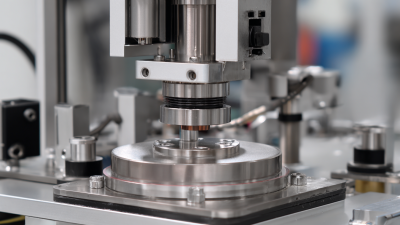Leave Your Message
In recent years, the home canning market has experienced a resurgence, driven by the growing interest in sustainable living and food preservation. According to a report by the Specialty Food Association, 30% of households in the United States are now participating in home canning, highlighting a significant shift toward DIY food preparation. Central to this process is the Can Sealer Machine, which not only enhances the efficiency of the canning process but also ensures a secure seal that preserves the quality and safety of canned goods.
 With advancements in technology, modern can sealer machines offer features such as adjustable sealing settings and increased durability, making them an essential tool for both novice and experienced canners alike. This guide aims to unlock the potential of these machines, providing readers with optimal techniques to maximize their home canning efforts while ensuring the best outcomes for their delicious creations.
With advancements in technology, modern can sealer machines offer features such as adjustable sealing settings and increased durability, making them an essential tool for both novice and experienced canners alike. This guide aims to unlock the potential of these machines, providing readers with optimal techniques to maximize their home canning efforts while ensuring the best outcomes for their delicious creations.
Can sealer machines have revolutionized home canning by streamlining the process of preserving food and extending shelf life. These machines operate by creating a vacuum seal that prevents air from entering the can, thereby inhibiting the growth of bacteria, yeast, and mold. According to industry reports, utilizing can sealer machines can reduce spoilage rates by up to 80%, making them invaluable for home canners looking to maximize their food preservation efforts.
Understanding the functionality of can sealer machines is crucial for achieving optimal results. Most machines employ a combination of heat and pressure to ensure that lids are properly sealed. In fact, studies have shown that proper sealing techniques can enhance the can's ability to withstand temperature fluctuations, which is particularly important for maintaining the quality of contents. The National Center for Home Food Preservation suggests that using a reliable can sealer significantly increases safety and effectiveness in home canning processes, providing amateurs with the tools necessary to preserve their harvest season after season.
When it comes to home canning, having the right tools and materials is critical to ensure safety and effectiveness. According to the USDA, nearly 2.5 million home canning enthusiasts engage in this age-old practice, which underscores the importance of using reliable equipment. Essential tools include high-quality can sealers, which not only streamline the sealing process but also enhance the shelf-life of the canned goods. The right canning jars, lids, and bands must be selected to create an airtight seal, protecting the contents from spoilage and contamination.
In addition to basic canning supplies, a few specialized instruments can significantly improve results. For instance, a jar lifter is essential for safely handling hot jars, while a canning funnel prevents spills during the filling process. According to a 2021 report from the National Center for Home Food Preservation, using these tools can reduce the risk of jar breakage and ensure a better seal, ultimately leading to higher success rates in home canning. Investing in these essentials not only enhances the canning experience but also ensures that homemade preserves are enjoyed long after the harvest season.
 Using a can sealer machine can make your home canning experience efficient and enjoyable. To get started, ensure that you have all necessary materials prepared, including clean jars, lids, and the food items you wish to seal. Begin by washing your jars thoroughly and sterilizing them in boiling water for at least 10 minutes. Once they cool, fill each jar with your prepared food, leaving the recommended headspace to avoid spillage during sealing.
Using a can sealer machine can make your home canning experience efficient and enjoyable. To get started, ensure that you have all necessary materials prepared, including clean jars, lids, and the food items you wish to seal. Begin by washing your jars thoroughly and sterilizing them in boiling water for at least 10 minutes. Once they cool, fill each jar with your prepared food, leaving the recommended headspace to avoid spillage during sealing.
Tips: Always check the manufacturer's instructions for your specific can sealer model to guarantee safety and functionality. A common practice is to warm the lids before sealing, as this helps create a better seal. Additionally, using a ruler or canning funnel can ensure an even fill, making the sealing process smoother.
After filling your jars, place the lids on top and adjust the can sealer machine according to its guidelines. It's crucial to maintain even pressure while sealing to prevent any gaps. Once you're done, allow the jars to cool completely. You should hear a "pop" sound, indicating a proper seal. Make sure to label your jars with the contents and date for future reference.
Tips: Inspect the seals after cooling; any unsealed jars can be refrigerated and consumed shortly after. Regularly check for the proper operation of your can sealer, as wear and tear can affect your results. Enjoy canning with confidence, knowing your techniques will preserve quality flavors for months to come!
Home canning is a rewarding practice that allows individuals to preserve their food while enjoying the fruits of their labor throughout the year. However, many home canners inadvertently make common mistakes that can compromise the safety and quality of their canned goods. According to the USDA, improper canning techniques can lead to spoilage and even foodborne illnesses, such as botulism, which can be fatal. One of the most frequent errors includes using incorrect processing times or temperatures, which vary depending on the type of food being canned.
Another common mistake is neglecting to check the seal integrity prior to storage. A 2021 survey by the National Center for Home Food Preservation found that approximately 35% of home canners do not perform a thorough inspection of their jar’s seals, leading to potential spoilage. In addition, failing to use proper equipment, like can sealer machines, can result in inadequate seals and a higher risk of contamination. Investment in reliable can sealing technology, coupled with adherence to recommended food preservation practices, is crucial for ensuring that home canning remains a safe and enjoyable activity.
When it comes to home canning, food safety is paramount. According to the USDA, over 48 million people in the United States suffer from foodborne illnesses annually, emphasizing the need for meticulous preservation techniques. One critical factor in ensuring food safety is the proper use of can sealer machines. These machines not only prevent the ingress of contaminants but also create a vacuum seal that inhibits the growth of bacteria, molds, and yeasts. It is recommended to achieve a vacuum seal level of at least 20 inches of mercury to ensure long-lasting preservation.

In addition to sealing techniques, selecting the right type of canning jars and lids is essential for maintaining the quality of home-canned goods. The National Center for Home Food Preservation suggests using new lids each time, as reused lids may not create an adequate seal. Furthermore, maintaining the right processing time and temperature is crucial; for example, low-acid foods such as vegetables require pressure canning at a minimum temperature of 240°F to eliminate botulinum spores effectively. By following these guidelines and utilizing advanced can sealer technology, home canners can enjoy both safety and the finest quality in their preserved foods.






